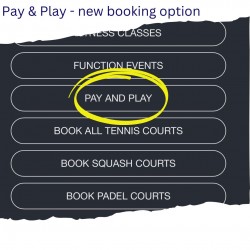Events
Stretches from Sandra - 4 mins
Posted on 27th May 2020
With many tennis (and padel!) players returning to court, the ever knowledgeable Sandra shares some stretches and self-care tips for tennis elbow. Sound on to benefit from Sandra's expertise, then scroll down and learn more about this common complaint and how you can prevent and/or treat it.
Sandra also says,
"Ease back gradually if you haven’t played tennis for several weeks. Periods of inactivity followed by an increased level of hitting has an impact on the musculoskeletal system (especially in more mature people) - the MS system undergoes qualitative changes in response to levels of physical activity.
Lateral elbow tendinitis occurs in other racket sports too such as squash and badminton or through work, ie carpenters, electricians, basically any action that is repetitive/one sided movement. It's most common in tennis players 35-59 years of age.
Frequency of play has a direct relationship with pain - it's characterised by high activity level and often affects players who play 3 or more times a week. Faulty technique, inadequate fitness levels and a sharp rise in playing after a period of inactivity are also common causes.
The anatomy of lateral elbow tendinosis related to tennis involves primarily the extensor carpi radialis brevis and secondarily the extensor digitorum communis muscle tendons. The bellies of the relevant muscles are all located in the forearm, while the long tendons bridge the elbow and wrist joints and insert on the metacarpals or phalanges (fingerbones). The lateral epicondyle of the humerus forms a common origin for a least parts of all the extensors of the wrist and fingers.
Tennis elbow is a degenerative process that is secondary to tensile overuse fatigue, weakness and possibly poor circulation. Pain mainly affects the lateral aspect of the elbow but can also radiate upwards along the upper arm and downwards along the outside of the forearm. Weakness in the wrist can also sometimes be felt, eg lifting a plate or pouring water from the kettle.
Just a few Preventative measures:
- Correct grip size on your racket.
- Balls should be light (ie no wet balls!).
- The ball should be hit correctly (good technique and fitness levels).
- Following through the stroke, wrist stays firm.
- Posture should be correct.
- Stringing of your racket appropriate for each individual.
A few treatment options:
- Reduce pain and inflammation when the injury is acute.
- Cooling (ice applied).
- Rest!
- Alternating ice and heat when the injury isn’t acute.
- Taping the wrist to support the elbow joint under load.
- Massage the forearm extensors and help to reduce tension in the forearm.
- Wear a tennis elbow support."
Thank you Sandra!
_250_250_90_c1.jpg)

_250_250_90_c1.jpg)
_250_250_90_c1.jpg)